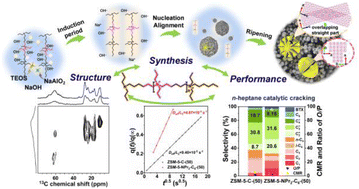Multiscale structural control of MFI zeolite using poly-quaternary ammonium cation†
Abstract
Tailoring the morphology of zeolite crystals has the potential to improve their mass transport and catalytic properties, which critically relies on the design of organic structure directing agents (OSDAs). As a prototype for studying the nucleation and growth of zeolitic materials and a broadly used catalyst, MFI zeolite is often fabricated in the presence of molecular or surfactant types of OSDAs. Here, a polycation [–N+(CH2CH2CH3)2–(CH2)6–]n[OH−]n, which is conceptually equivalent to a bond-linked tetrapropyl ammonium cation (the normally used OSDA to generate MFI topology), is designed. The morphology of synthetic products depends on Na+ and Al contents in the initial sols. Highly crystalline, reduced a-axis (8–18 nm), and 36° rotationally intergrown nanosheets can be generated with Si/Al of 50 in the presence of Na+, while leaf-shaped bulky crystals growing along the b–c planes are obtained in the absence of Al or Na+. The control syntheses using polycations differ slightly in chain spacer, and branching lengths highlight the matching between the length of the methylene chain spacer and the length between micropore intersections for tailoring crystal anisotropic growth. The crystallization proceeds through three consecutive events: wrapping up of the polycation by inorganic precursors, nucleation and oriented alignment, requiring a prolonged induction period as the organization of inorganic precursor is sterically hindered. The hierarchical material exhibits high activity, stability and light olefin selectivity in n-heptane catalytic cracking owing to high crystallinity, improved diffusion property and strong acidity. The OSDA design concept opens a new avenue for manipulating zeolite structures to enhance their properties.

- This article is part of the themed collections: 2023 Journal of Materials Chemistry A HOT Papers and #MyFirstJMCA


 Please wait while we load your content...
Please wait while we load your content...